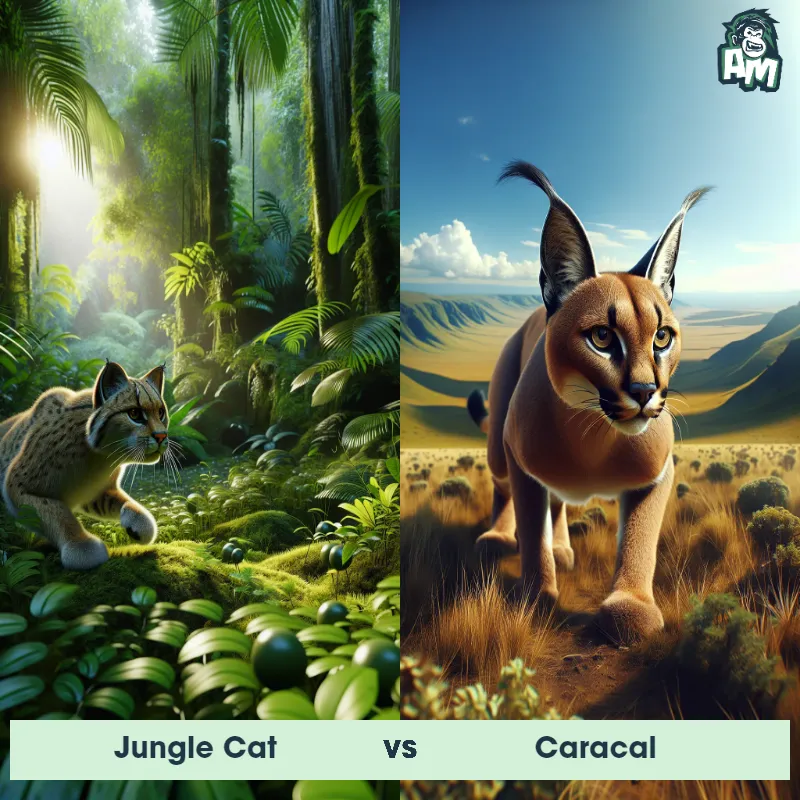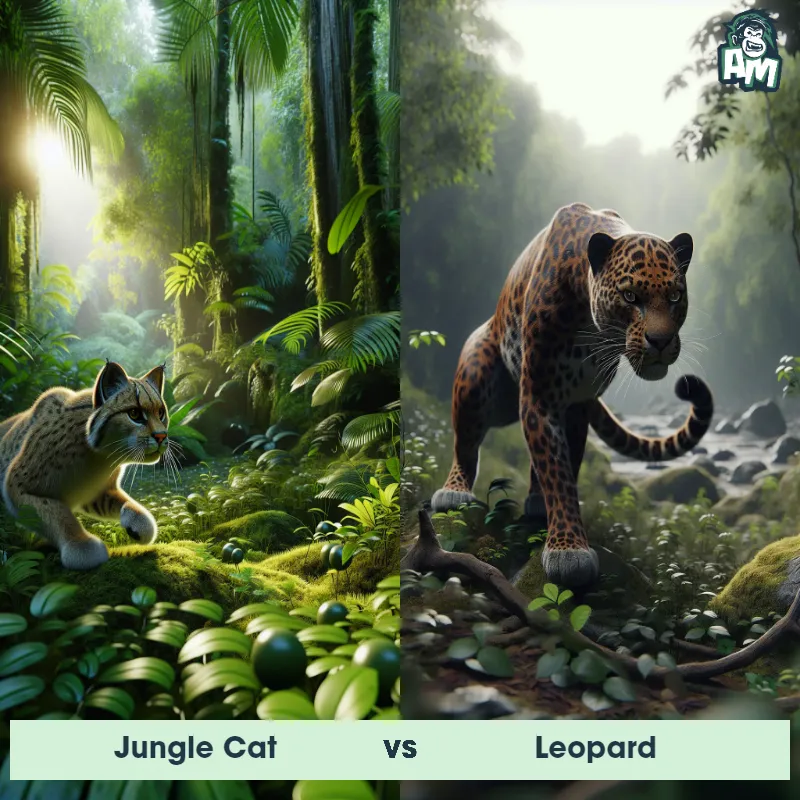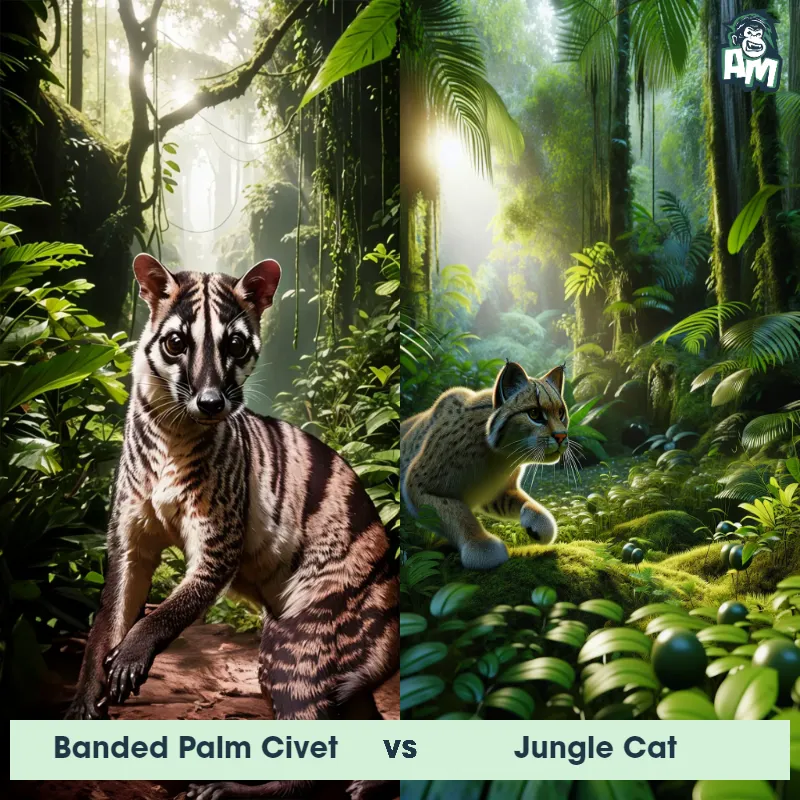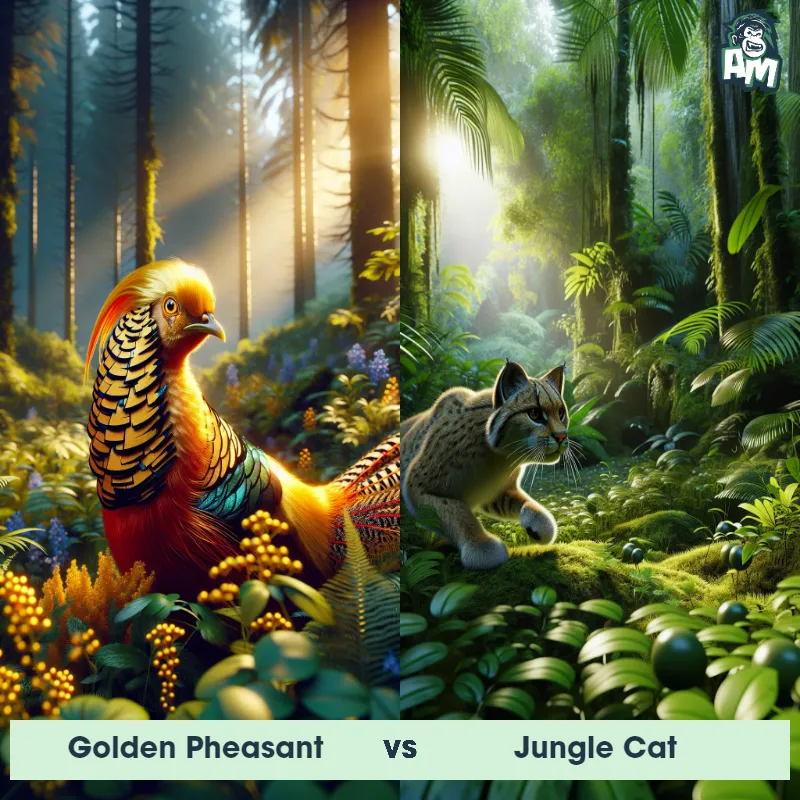The Jungle Cat
The Jungle Cat, also known as Felis chaus, is a medium-sized wild cat species that inhabits various regions of Asia, including India, Sri Lanka, Pakistan, and Southeast Asia. Known for their distinctive appearance, these cats have a relatively long, slim body with short legs and a relatively short tail. They have a sandy or tawny-colored coat with black stripes, spots, and a white belly. Jungle Cats have large, rounded ears with black tufts, which give them excellent hearing abilities. They have been found in a wide range of habitats, from wetlands and marshes to dry grasslands and forests.

| Jungle Cat | |
|---|---|
| Size | Height: 12-16 inches (30.5-40.6 cm), Length: 24-36 inches (61-91 cm) |
| Weight | 11-26 pounds (5-12 kg) |
| Speed | 20mph (32km/h) |
| Key Strength | Agile and swift |
| Biggest Weakness | None specified |
| Scientific Name | Felis chaus |
| Family | Felidae |
| Habitat | Wetlands and grasslands |
| Geography | Asia |
| Diet | Small mammals, birds, reptiles |
| Lifespan | 9 years - 15 years |

The Jungle Cat
The Jungle Cat, also known as Felis chaus, is a medium-sized wild cat species that inhabits various regions of Asia, including India, Sri Lanka, Pakistan, and Southeast Asia. Known for their distinctive appearance, these cats have a relatively long, slim body with short legs and a relatively short tail. They have a sandy or tawny-colored coat with black stripes, spots, and a white belly. Jungle Cats have large, rounded ears with black tufts, which give them excellent hearing abilities. They have been found in a wide range of habitats, from wetlands and marshes to dry grasslands and forests.
Fun Fact: The Jungle Cat is an exceptional swimmer and is known to be quite comfortable in water. They are often seen hunting and swimming in the shallow waters of lakes or ponds, using their strong, webbed feet to help them navigate through the water with ease.
| Jungle Cat | |
|---|---|
| Size | Height: 12-16 inches (30.5-40.6 cm), Length: 24-36 inches (61-91 cm) |
| Weight | 11-26 pounds (5-12 kg) |
| Speed | 20mph (32km/h) |
| Key Strength | Agile and swift |
| Biggest Weakness | None specified |
| Scientific Name | Felis chaus |
| Family | Felidae |
| Habitat | Wetlands and grasslands |
| Geography | Asia |
| Diet | Small mammals, birds, reptiles |
| Lifespan | 9 years - 15 years |
Jungle Cat Matchups
We use AI to simulate matchups between the Jungle Cat and other animals. Our simulation considers size, strength, and natural predatory behaviors to determine the most likely outcome.
Jungle Cat: Diet, Predators, Aggression, and Defensive Behaviors
What do Jungle Cats eat?
Jungle Cats are carnivores, primarily feasting on small mammals such as rodents, birds, reptiles, and insects. They are also known to include frogs, fish, and even domestic poultry in their diet. With their keen hunting skills and agility, they are able to catch their prey both on land and in water.
Do Jungle Cats have any predators?
Jungle Cats are relatively small predators themselves, so they do have predators that pose a threat to them. Their main predators include larger carnivorous animals such as leopards, pythons, and crocodiles. Additionally, human activities such as habitat destruction and illegal hunting also pose a threat to the Jungle Cat population.
Are Jungle Cats aggressive?
Jungle Cats are generally solitary animals and tend to be quite elusive and shy around humans. While they are not typically aggressive towards humans, they may display defensive behaviors if they feel threatened or cornered. However, they are known to be territorial and may exhibit aggression towards other Jungle Cats encroaching on their territory.
Do Jungle Cats fight?
Jungle Cats are known to engage in territorial disputes with other individuals of the same species, especially during breeding season. These disputes may involve physical confrontations such as swatting, biting, and growling. However, these fights are usually brief and are meant to establish dominance rather than cause serious harm.
How do Jungle Cats defend themselves?
Jungle Cats have several defense mechanisms to protect themselves from predators and other threats. They are adept climbers and may seek refuge in trees to escape danger. They also have sharp retractable claws and teeth that they can use in self-defense if necessary. Additionally, their agile and swift movements help them evade potential threats in their environment.
What is the biggest weakness of Jungle Cats in a fight?
One of the biggest weaknesses of Jungle Cats in a fight is their relatively small size compared to some of their predators or larger competitors. While they are agile and have sharp claws and teeth, their small stature can make them vulnerable in confrontations with larger animals. Additionally, their solitary nature means they may lack the backup or support that some other species enjoy in fights.
Fun Fact: Jungle Cats are incredibly skilled hunters and have a diverse diet. While they primarily feed on small rodents like rats and mice, they are also known to prey upon birds, frogs, reptiles, fish, and even insects.
Fun Fact: Unlike many other species of wild cats, Jungle Cats are primarily active during twilight hours, meaning they are crepuscular. This adaptive behavior allows them to avoid competition with other larger predators that are more active during the day or at night, such as tigers and leopards.
















